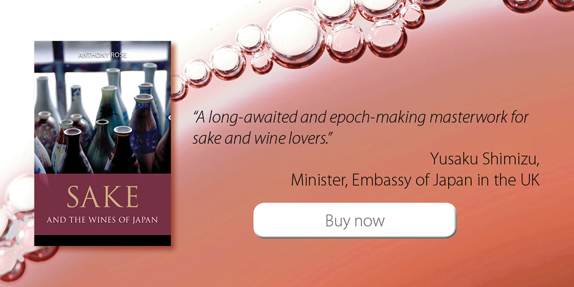After small-batch gins and craft beers here’s the next big thing: sake
22 October 2018 by Rebecca in Classic Wine Library, Wine and spirits
Sake is about to hit the big time as it becomes the latest drink adopted by today’s trendsetting urbanites. After years spent languishing in the doldrums, sake’s popularity has grown to such an extent over the last decade that UK wine specialist Majestic recently added three premium sakes to its range, and it is even being produced outside of Japan. Anybody in doubt as to the drink’s hipster credentials need only note the location of some of those breweries – Peckham, London; Portland, Oregon and of course Brooklyn.
But sake has much more to offer than the promise of making its drinker seem in vogue, as Anthony Rose demonstrates in a new book, Sake and the wines of Japan. The craftsmanship involved in the drink (with often obsessive regard to rice polishing ratios), its simple ingredients and the years of tradition captured in each glass make it easy to see how it would appeal to those previously infatuated with gin’s botanicals or the mix of hops in their IPA. But its artisan credentials and complexity also make it a challenging and rewarding drink for all involved in a serious pursuit of new and intriguing flavours.
As Rose notes, sake is a drink ideally suited to being tasted with food. Indeed after years of attempting to unravel sake’s mysterious appeal during wine-style tastings he finally got to grips with it during a relaxed meal: “Someone ordered sake and as I was drinking it with the hotpot, all of a sudden, I found myself enjoying it … At a moment in time when I’d stopped thinking about it from a tasting perspective, I found myself lapping it up.”
It is not really possible to fully appreciate sake without examining the culture, history and landscape of its country of origin. As Rose points out: “Sake is both a drink and a window onto Japanese society. To delve into sake is to time-travel through centuries of ambition, grit in times of hardship, and outstanding imagination and achievement.” One might argue that when sake sales began to decline it was because, during the shortages that followed the Second World War, brewers found it necessary to do the best they could with limited resources (cut corners, if you will), simultaneously losing sight of the centuries of craftsmanship that had made sake Japan’s national drink. But the new generation of brewers, many of whom can claim family links to sake-production dating back to the drink’s heyday in the Edo Period, teams old-style production purity with a modern outlook, opening the drink up to the world.
Sake and the wines of Japan covers all essential aspects of sake for the newcomer, including the four simple ingredients – rice, kōji, water and yeast – the sake-making process, sake classification and sake tasting. Rose includes a personal selection of sake brewers as well as an interesting chapter spotlighting sake’s new wave. An essential tool for all those seeking a way into this enigmatic and enticing culture, it also includes a chapter on Japan’s small, young wine industry and its best exponents, and a guide to Japan for those visiting the country.
Anthony Rose is an award-winning wine and sake critic who contributes to publications that include Decanter, The World of Fine Wine, Financial Times How to Spend It online and The Oxford Companion to Wine. He is co-chair of the Australia panel at the Decanter World Wine Awards and the Sake International Challenge in Tokyo and teaches a sake consumer course at Sake No Hana in London. A founding member of The Wine Gang (www.thewinegang.com), he was the wine correspondent of the print version of the Independent from start to finish (1986–2016).
Sake and the wines of Japan is published on 29 October 2018. Review copies are available from marketing@infideas.com

